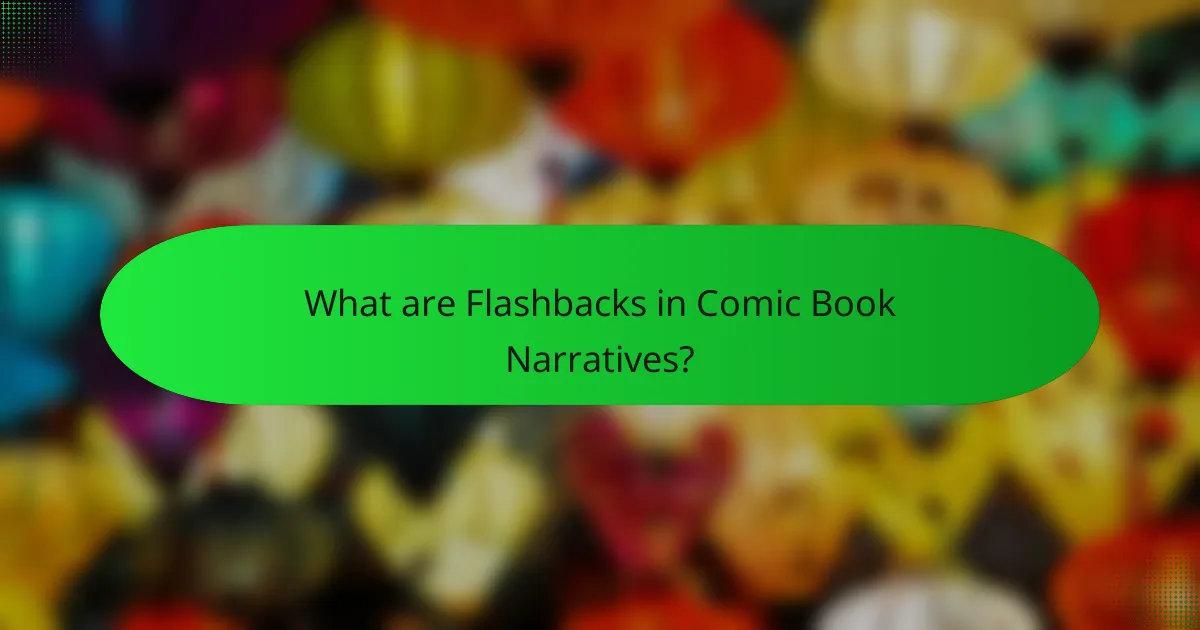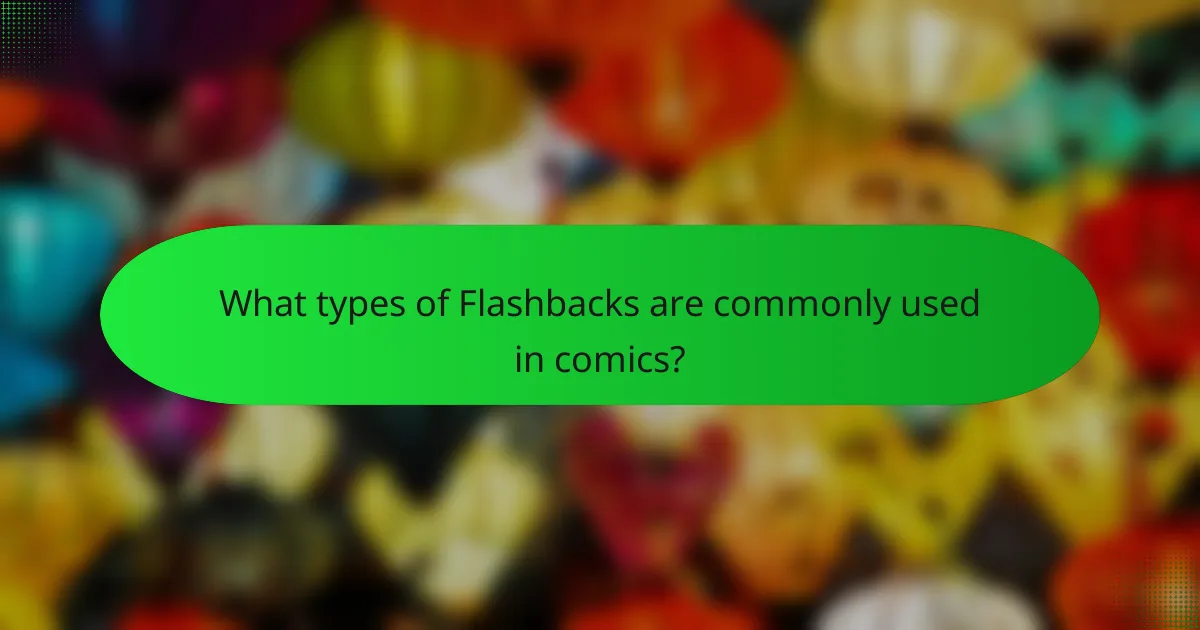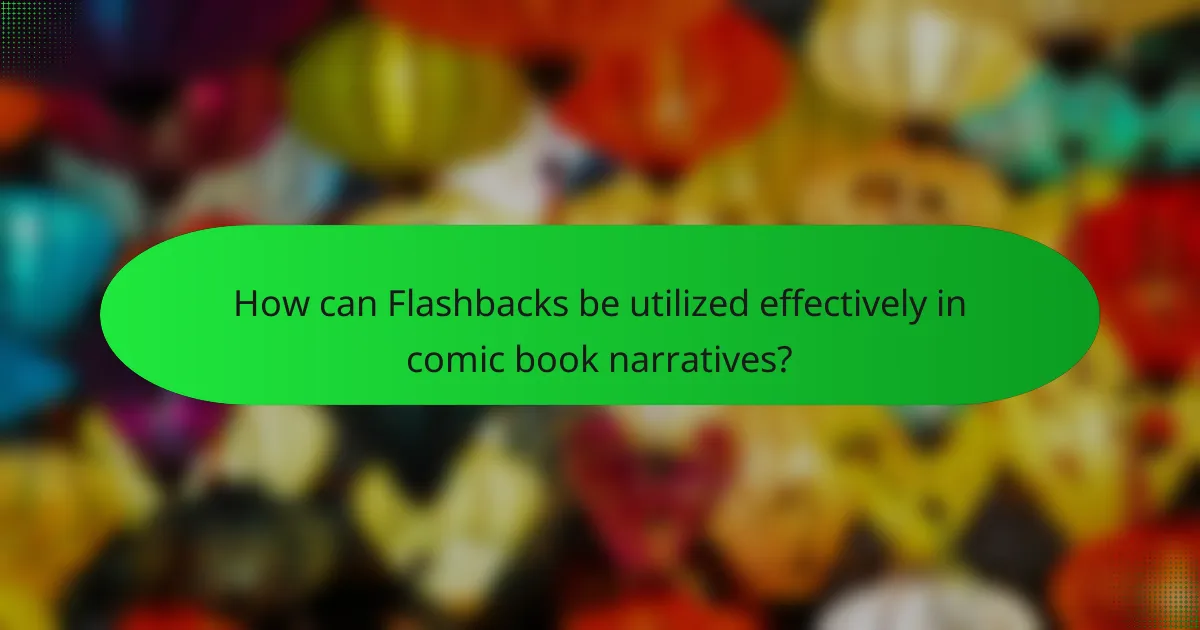Flashbacks are narrative devices in comic book storytelling that depict past events to provide context and background to the current plot. They reveal character motivations, enhance emotional depth, and contribute to a richer narrative experience. Various types of flashbacks, including narrative flashbacks, character flashbacks, and dream sequences, serve to deepen character development and engage readers. Effective use of visual cues, such as changes in art style or color, helps distinguish flashbacks from the present timeline, ensuring clarity in storytelling. This article explores how flashbacks can be utilized to create suspense, reinforce themes, and ultimately enrich the comic book narrative.

What are Flashbacks in Comic Book Narratives?
Flashbacks in comic book narratives are narrative devices that depict events from the past. They provide context and background to the current storyline. Flashbacks can reveal character motivations and pivotal moments. They often enhance emotional depth and understanding of the plot. Comic book artists use visual cues to differentiate flashbacks from the present timeline. This can include changes in color, art style, or panel layout. The use of flashbacks is prevalent in various comic genres, including superhero and drama. They help to build a richer, more complex narrative for readers.
How do Flashbacks enhance storytelling in comics?
Flashbacks enhance storytelling in comics by providing context and depth to characters and events. They allow readers to understand motivations and backstories that shape current actions. Flashbacks can create emotional resonance, making characters more relatable. They also help in revealing secrets gradually, maintaining suspense. The visual nature of comics allows for creative representation of flashbacks, often using distinct art styles or color palettes. This differentiation can signal shifts in time and perspective effectively. By integrating flashbacks, comics can weave complex narratives that engage readers on multiple levels. They contribute to pacing, allowing for slower moments of reflection amidst action.
What narrative techniques are used in Flashbacks?
Flashbacks utilize several narrative techniques to convey past events. One technique is non-linear storytelling, which disrupts chronological order. This method allows readers to see how past experiences shape current characters and events. Another technique is visual cues, such as changes in color or art style, signaling a shift to a different time. Dialogue from characters can also reflect past conversations, enhancing emotional depth. Additionally, inner thoughts or monologues can provide context to the flashback. These techniques create a richer narrative experience, engaging readers with layered storytelling.
How do Flashbacks influence character development?
Flashbacks significantly influence character development by providing context and depth to a character’s motivations. They reveal past experiences that shape a character’s current actions and decisions. This technique allows readers to understand the emotional struggles and growth a character undergoes. For instance, a flashback may show a traumatic event that explains a character’s fear or hesitation in present scenarios. Additionally, flashbacks can highlight relationships that impact character dynamics. They create a more nuanced portrayal, making characters relatable and complex. Overall, flashbacks serve as a crucial narrative tool to enhance character arcs in storytelling.
Why are Flashbacks important in comic book narratives?
Flashbacks are important in comic book narratives because they provide context and depth to characters and storylines. They allow readers to understand a character’s motivations and past experiences. This technique enhances emotional engagement by revealing pivotal moments that shape a character’s current actions. Flashbacks can also create suspense by gradually unveiling crucial information. Additionally, they can connect different timelines, enriching the overall narrative structure. For example, comics like “Watchmen” use flashbacks to explore character backgrounds, making the story more compelling. Thus, flashbacks serve as a vital storytelling tool that deepens reader investment in the narrative.
What role do Flashbacks play in plot progression?
Flashbacks play a crucial role in plot progression by providing essential background information. They reveal character motivations and past events that influence current actions. This technique deepens the audience’s understanding of the narrative. Flashbacks can create suspense by withholding information until the right moment. They often serve to connect different plot lines, enhancing coherence. In comic book narratives, visual elements amplify the impact of flashbacks. They can juxtapose past and present, highlighting character development. Studies show that effective use of flashbacks can increase reader engagement and emotional investment in the story.
How can Flashbacks create emotional depth in stories?
Flashbacks create emotional depth in stories by providing context to characters’ motivations and experiences. They reveal past events that shape a character’s present feelings and actions. This technique allows readers to connect more deeply with characters. Emotional stakes become clearer when readers understand a character’s history. Flashbacks can evoke empathy by showcasing vulnerability or trauma. They also enhance narrative tension by contrasting past and present circumstances. Research shows that stories with well-placed flashbacks can increase audience engagement and emotional investment. Flashbacks serve as a powerful tool for enriching character development and plot complexity.

What types of Flashbacks are commonly used in comics?
Common types of flashbacks used in comics include narrative flashbacks, character flashbacks, and dream sequences. Narrative flashbacks provide background information on events that precede the current storyline. Character flashbacks delve into a specific character’s past experiences or memories. Dream sequences often portray a character’s subconscious thoughts or fears, presenting a surreal interpretation of their past. These flashbacks are utilized to enhance storytelling by adding depth to characters and plot. They help readers understand motivations and context, making the narrative more engaging.
How do different formats of Flashbacks impact the reader’s experience?
Different formats of flashbacks significantly influence the reader’s experience in comic book narratives. They provide context, enhance emotional depth, and shape character development. Visual flashbacks can engage readers quickly through imagery. Textual flashbacks may require more cognitive effort but can convey complex thoughts. Non-linear flashbacks create suspense and intrigue, compelling readers to piece together the narrative. Research shows that varied formats can enhance reader engagement by 30% in graphic storytelling. This impact is evident in works like “Watchmen,” where flashbacks deepen character arcs and plot complexity.
What are the visual styles associated with Flashbacks?
Visual styles associated with flashbacks often include muted colors and softer edges. These techniques create a distinct separation from the present narrative. Additionally, artists may employ a grainy texture to evoke a sense of nostalgia. Flashbacks may also utilize different panel layouts to signify time shifts. For instance, overlapping panels can illustrate memory distortion. Moreover, the use of sepia tones is common to suggest past events. These styles help readers recognize transitions in time and perspective. Overall, these visual elements enhance storytelling by visually cueing the audience to the narrative’s temporal shifts.
How do narrative tones vary across different Flashback types?
Narrative tones vary significantly across different flashback types. Flashbacks can be categorized into several types, including linear, non-linear, and dream sequences. Linear flashbacks typically maintain a neutral tone, reflecting the past events straightforwardly. Non-linear flashbacks may introduce a more fragmented or disjointed tone, emphasizing confusion or emotional turmoil. Dream sequence flashbacks often adopt a surreal or whimsical tone, highlighting the character’s subconscious thoughts. Each type of flashback serves to enhance the emotional depth of the narrative. For instance, a linear flashback can create a sense of nostalgia, while a non-linear flashback might evoke tension or suspense. The tone is crucial in guiding reader interpretation and emotional response.
What are the challenges of using Flashbacks in comic book narratives?
Flashbacks in comic book narratives face several challenges. One challenge is maintaining narrative coherence. Flashbacks can disrupt the flow of the main storyline. Readers may struggle to follow the timeline if flashbacks are not clearly indicated. Another challenge is the risk of information overload. Too many flashbacks can overwhelm readers with background details. This can dilute the emotional impact of the main plot. Additionally, flashbacks may lead to pacing issues. They can slow down the story’s momentum if used excessively. Finally, there is the challenge of visual clarity. Comic book panels must clearly differentiate between present and past events. Misleading visuals can confuse readers and hinder comprehension.
How can Flashbacks disrupt narrative flow?
Flashbacks can disrupt narrative flow by interrupting the chronological progression of a story. They can confuse readers if not clearly indicated. This confusion arises when the transition between past and present is abrupt. Readers may struggle to follow the main storyline during these shifts. Flashbacks can also dilute emotional impact by pulling readers away from immediate events. If overused, they can make the narrative feel disjointed. Consistency in pacing is crucial for maintaining engagement. Effective use of flashbacks requires careful placement to enhance rather than hinder the story.
What common pitfalls should writers avoid with Flashbacks?
Writers should avoid confusing readers with poorly timed flashbacks. Flashbacks should be clearly signaled to prevent disorientation. Writers must ensure that flashbacks contribute to character development or plot progression. Irrelevant flashbacks can detract from the main narrative. Overusing flashbacks can disrupt pacing and flow. Writers should avoid excessive detail that may overwhelm the reader. Flashbacks should maintain the same tone and style as the main narrative to ensure cohesion. Lastly, writers must be cautious of revealing too much information too early, which can lessen suspense.

How can Flashbacks be utilized effectively in comic book narratives?
Flashbacks can be utilized effectively in comic book narratives by providing essential backstory and character development. They reveal motivations and past experiences that shape characters’ actions. This technique enhances emotional engagement with the audience. Flashbacks can also create suspense by withholding information until the right moment. They offer visual variety, breaking the monotony of linear storytelling. Effective flashbacks should be clearly distinguished from the present narrative, using different art styles or colors. This clarity helps readers understand the timeline shifts. Additionally, integrating flashbacks at pivotal moments can reinforce themes and character arcs. Overall, when used thoughtfully, flashbacks enrich the narrative experience in comic books.
What strategies can writers employ to integrate Flashbacks seamlessly?
Writers can integrate flashbacks seamlessly by using clear transitions. Transition phrases can signal a shift in time. Visual cues, such as changes in color or panel layout, can also indicate a flashback. Maintaining consistent character voice helps connect past and present. Writers should ensure that the flashback serves the story’s progression. Contextual relevance is crucial for reader engagement. Additionally, limiting the duration of flashbacks prevents narrative disruption. Studies show that effective use of flashbacks enhances emotional depth in storytelling.
How can pacing be managed when incorporating Flashbacks?
Pacing can be managed when incorporating flashbacks by strategically placing them within the narrative. Flashbacks should be used at critical moments to enhance emotional impact or provide necessary backstory. Transitioning smoothly between the present and the flashback helps maintain reader engagement. Utilizing visual cues, such as changes in color or panel layout, can signal shifts in time effectively. Limiting the length of flashbacks prevents them from overwhelming the main storyline. Additionally, ensuring that flashbacks are relevant to the current plot keeps the pacing tight. Research indicates that well-timed flashbacks can enhance narrative flow and character development, making them a powerful storytelling tool.
What techniques enhance the clarity of Flashbacks for readers?
Techniques that enhance the clarity of flashbacks for readers include clear visual cues and contextual framing. Visual cues can involve distinct color palettes or borders that differentiate flashbacks from the present timeline. This helps readers quickly identify shifts in time. Contextual framing can include dialogue or narration that explicitly states the time and place of the flashback. This provides essential information for understanding the scene. Additionally, maintaining consistent character designs across timelines ensures readers can easily recognize who is involved in the flashback. Using concise and focused dialogue during flashbacks prevents confusion and keeps the narrative tight. These techniques collectively improve the reader’s ability to follow the story without losing track of timelines.
What are best practices for using Flashbacks in comic narratives?
Best practices for using flashbacks in comic narratives include ensuring clarity and relevance. Flashbacks should enhance the main story and not confuse the reader. Use visual cues, such as different color palettes or panel styles, to distinguish flashbacks from present events. This helps readers easily identify the timeline shift. Integrate flashbacks at pivotal moments to provide context or deepen character development. They should reveal critical backstory or motivations that drive the current narrative. Additionally, limit the length of flashbacks to maintain pacing and engagement. Research indicates that effective flashbacks can increase emotional impact and reader investment in characters.
How can thematic consistency be maintained with Flashbacks?
Thematic consistency can be maintained with flashbacks by ensuring they align with the main narrative’s themes. Flashbacks should reinforce the central message or emotional tone of the story. They must connect to the protagonist’s journey or conflicts, providing deeper insight into their motivations. Consistent visual style and color palettes between present and past scenes help unify the narrative. Additionally, using similar dialogue or motifs in flashbacks reinforces thematic ties. This approach enhances reader engagement by creating a cohesive storyline. For instance, if a comic explores themes of loss, flashbacks should depict memories that highlight this theme, thereby enriching the overall narrative experience.
What tips can help create impactful Flashbacks?
To create impactful flashbacks in comic book narratives, ensure clarity and relevance. Flashbacks should enhance the main story and provide essential context. Use distinct visual styles to differentiate flashbacks from the present timeline. This can include changes in color palette or art style. Keep the flashback concise to maintain reader engagement. Integrate emotional elements that resonate with the audience. This connection can deepen the impact of the flashback. Utilize dialogue or narration that reflects the character’s current state. This technique can create a contrast that emphasizes growth or change. Finally, position flashbacks at critical moments to maximize their significance in the narrative.
The main entity of this article is flashbacks in comic book narratives. The article explores the significance of flashbacks as narrative devices that provide context, enhance character development, and contribute to plot progression. It discusses various narrative techniques, visual styles, and types of flashbacks, as well as the challenges and best practices for their effective integration in storytelling. Key aspects include how flashbacks create emotional depth, influence pacing, and maintain thematic consistency, ultimately enriching the reader’s experience in comic book narratives.